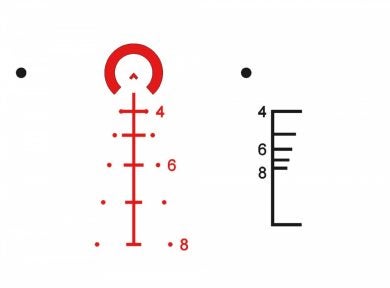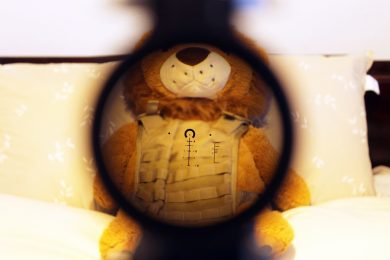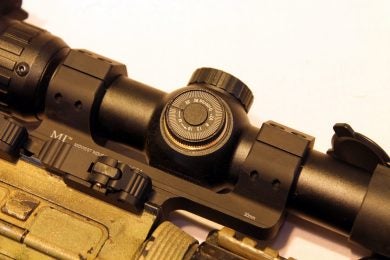Primary Arms has built a name for themselves by selling mid-priced optics that have decent quality. Not as expensive as a Trijicon but much better quality than UTG, Primary Arms has expanded their inventory over the years and earned a reputation for quality sights. Primary Arms also developed the ACSS reticle including a version for M855A1, which is now being evaluated for use by the US Marine Corps RCO. This reticle is really the star of the show in the 1-6x24mm so it’s worth spending some time on it before moving on to the other features.

The ACSS reticle
It has a lot going on but somehow manages not to be too busy. The horizontal stadia lines on the vertical post in the center match 18″ at the corresponding ranges, which happens to be the approximate width of an average adult male’s shoulders. The stadia lines also correspond to the bullet drop expected at that range. To fine tune the bullet drop for various loads, the sight comes with a table indicating the appropriate zero distance and height above POA for several popular bullet weights and velocities. The black bar on the right side of the reticle represents 5’10” at the corresponding ranges. This is helpful because the larger the object is that you are using to estimate range, the more accurate your estimate will be. The dots to either side of the central vertical post are 5 mph wind holds and the two larger dots are intended for a lead on a target running at 100 yards.

The ACSS reticle at 1x
The 1x setting is very close to a true 1 power with minimal distortion around the edges of the image. While many sights claim to have “daylight visible” illumination, they really just mean that you can tell the reticle is illuminated during daylight hours. This sight literally goes up to 11 and is bright enough that it really pops in full sun. It isn’t as bright as a TA31 fiber optic illuminated reticle, but it does grab your attention. The glass is not as clear as higher end optics, there’s no getting around that fact, but for the price, you can’t really expect it to be equal to Leupold or Schmidt & Bender. It is still better than many of its peers in price. I have a Burris that isn’t quite as crisp and gathers less light with a larger objective lens.

Windage knob
The controls are positive and easy to operate with several nice touches. The windage ant elevation turrets have a zero ring that you can set to easily return to zero, should sight corrections be necessary. The brightness adjustment knob goes all the way around so you can go from 0 to 11 with one click and the cap for the brightness knob has a spot for a spare battery. Even better, it actually came with two batteries. One installed, and the other in the spare compartment. While I haven’t intentionally left it on to measure battery performance, I did accidentally leave it on at about 8 over a three day weekend. It was still bright when I discovered that it was on. The battery isn’t going to last 50,000 hours like an Aimpoint, but it is also an etched reticle so it still works whether or not it’s illuminated and I found myself leaving the illumination off, except for low light conditions.
Overall, this is a fantastic sight for the money and highly versatile. If you can afford to spend three times as much, you can certainly buy a better sight, but I’m not convinced that you can find one that is three times as good for any price.
 Your Privacy Choices
Your Privacy Choices
